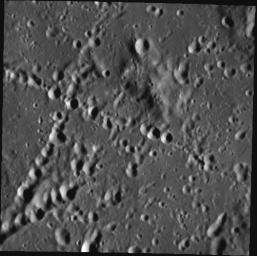
|
The Land of Crater Chains
- Click the image above for a larger view
- Full-Res JPEG (527 x 524) (40.5 kB)
- Full-Res TIFF (527 x 524) (276.6 kB)
Caption:
This image, taken with the Narrow Angle Camera (NAC), gives us a close-up view of newly named Stevenson crater. One of the 23 Mercury craters recently assigned names by the IAU, Stevenson crater was named in honor of Robert Louis Stevenson, the nineteenth century author best known for The Strange Case of Dr. Jekyll and Mr. Hyde as well as A Child's Garden of Verses , a classic collection of poems including The Swing and The Land of Counterpane . Stevenson crater is known for the distinct X-shape made by the secondary crater chains crisscrossing its floor, the result of falling ejecta from two primary impacts outside the field of view.
This image was acquired as part of MDIS's high-incidence-angle base map. The high-incidence-angle base map is a major mapping activity in MESSENGER's extended mission and complements the surface morphology base map of MESSENGER's primary mission that was acquired under generally more moderate incidence angles. High incidence angles, achieved when the Sun is near the horizon, result in long shadows that accentuate the small-scale topography of geologic features. The high-incidence-angle base map is being acquired with an average resolution of 200 meters/pixel.
Date acquired:
April 10, 2012
Image Mission Elapsed Time (MET):
242504076
Image ID:
1627702
Instrument:
Narrow Angle Camera (NAC) of the Mercury Dual Imaging System (MDIS)
Center Latitude:
1.79°
Center Longitude:
216.2° E
Resolution:
159 meters/pixel
Scale:
Stevenson crater is 134 km (83 miles) in diameter. This image displays about 81 km (50 miles) of the crater's floor.
Incidence Angle:
71.4°
Emission Angle:
7.4°
Phase Angle:
64.0°
Background Info:
The MESSENGER spacecraft is the first ever to orbit the planet Mercury, and the spacecraft's seven scientific instruments and radio science investigation are unraveling the history and evolution of the Solar System's innermost planet. Visit the Why Mercury? section of this website to learn more about the key science questions that the MESSENGER mission is addressing. During the one-year primary mission, MDIS acquired 88,746 images and extensive other data sets. MESSENGER is now in a year-long extended mission, during which plans call for the acquisition of more than 80,000 additional images to support MESSENGER's science goals.
These images are from MESSENGER, a NASA Discovery mission to conduct the first orbital study of the innermost planet, Mercury. For information regarding the use of images, see the MESSENGER image use policy .
Cataloging Keywords:
| Name | Value | Additional Values |
|---|---|---|
| Target | Mercury | |
| System | ||
| Target Type | Planet | |
| Mission | MESSENGER | |
| Instrument Host | MESSENGER | |
| Host Type | Orbiter | |
| Instrument | Mercury Dual Imaging System (MDIS) | |
| Detector | Narrow Angle Camera (NAC) | |
| Extra Keywords | Crater, Grayscale, Impact, Map, Radio, Shadow | |
| Acquisition Date | ||
| Release Date | 2012-05-23 | |
| Date in Caption | 2012-04-10 | |
| Image Credit | NASA/Johns Hopkins University Applied Physics Laboratory/Carnegie Institution of Washington | |
| Source | photojournal.jpl.nasa.gov/catalog/PIA15781 | |
| Identifier | PIA15781 | |
